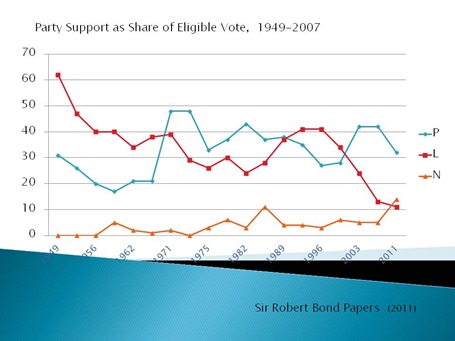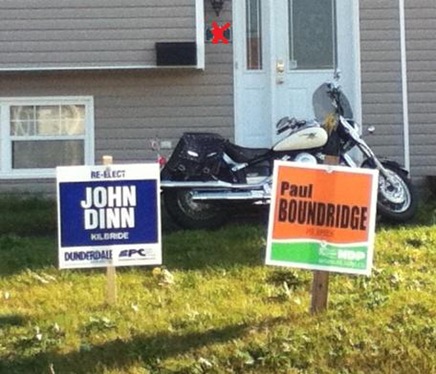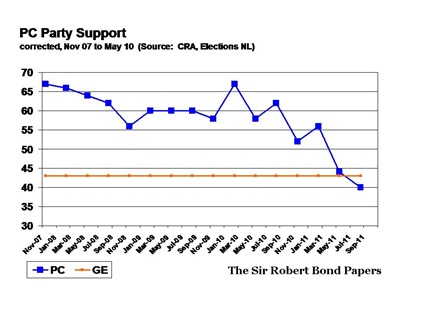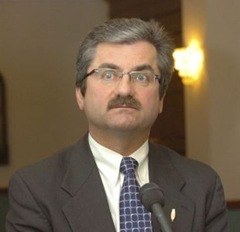All daily media in the province reported polls released by polling firms during the 2011 general election.
They reported the polls as the firms released them. That is, they did not question or alter the presentation of the numbers, nor did they discuss the different methodology used to generate them. This CBC report is typical.
The second MQO poll, released on September 30 stands out in particular as a result of the way it was reported. This poll prompted a news release from Liberal leader Kevin Aylward that we’ll discuss in greater detail in the final segment of this series.
What’s most interesting about the second MQO poll is the way the firm reported the results for a question it asked on the leaders’ debate.
One can make a theoretical argument about eliminating undecideds in the presentation of a party choice question. Some pollsters would claim this would allow you to match their poll result with the popular vote on election day.
But there’s no reason to alter the presentation of the results in such a way for any other sort of question. Yet that is exactly what MQO did with the leaders’ debate question. For some inexplicable reason, MQO reported the results in such a way that they placed the emphasis on those who watched the debate. They then presented their responses as if those who reportedly watched the debate was 100% of the sample.
When asked about the leaders’ debate, 34 per cent of those polled said they watched the televised leaders’ debate on Wednesday, September 28. Of those respondents who watched the debate, 36 per cent felt Kathy Dunderdale won the debate, while Lorraine Michael was seen as the winner by 22 per cent, and six per cent said Kevin Aylward came out on top. The remainder of respondents said there was no clear winner of the debate.
The result was this sort of presentation in news stories:
The poll poses serious questions for Kevin Aylward and the Liberals who have been struggling through the campaign with an accumulated debt and difficulty with recruiting candidates.
Of respondents who had watched the leaders' debate on Wednesday night, only six per cent said Aylward won it. By contrast, 36 per cent chose PC Leader Kathy Dunderdale and 22 per cent chose NDP Leader Lorraine Michael.
"The remainder of respondents said there was no clear winner of the debate," MQO said in a statement.
In the rush to write a news story, no reporters caught that 66% of the respondents didn’t watch the debate. They didn’t adjust the rest of MQO’s numbers accordingly. The result is that MQO’s misleading presentation of its results survived into news casts.
Aside from the MQO and Environics polls released by the companies themselves to all media, two of the province’s major media outlets commissioned polls for the 2011 election.
NTV commissioned their usual pollster, Telelink, to conduct a poll similar to ones they have done with Telelink on several occasions over the past six years.
The poll served the usual purpose. It gave NTV exclusive news content as well as a marketing opportunity. NTV was also able to ask a question on Muskrat falls similar to one from an NTV/Telelink poll in February. As such, NTV was able to describe not only the results of the new poll but the trend – in this case a decline in support – from the earlier poll.
The Telegram commissioned CRA to conduct a poll with what turned out to be the largest sample of any poll conducted during the election.
Consistent with experience elsewhere, the Telegram used the poll to generate large amounts of original content in addition to reaction pieces. The poll was the centrepiece of the paper’s election coverage over three days, beginning on October 6.
The poll, however, did not add significant new information to any other poll results. The Saturday edition - October 8 - featured responses to questions on the so-called rural-urban divide. However, the questions – which party do you think best deals with rural issues and so on – basically mirrored the satisfaction questions without adding significant depth or colour to public understanding of the issues and public opinion. “Satisfaction” questions ask respondents to indicate how satisfied they are with government performance on a given topic.
The Saturday edition of the Telegram also reported on another key question. The Telegram asked respondents which party they would chose if Danny Williams was still the Tory leader.
Curiously, the Telegram found that health care was overwhelmingly the major issue for respondents, just as CRA polls for the provincial government reported for the past year. However, the Telegram did not probe any dimensions of that opinion. What is it about health care that people are so concerned about?
The most significant aspect of the media and polls during the 2011 election was not what the media reported of specific polls during the election. Rather it was the conclusion that news media drew from the CRA quarterly omnibus results and then the subsequent polls.
The Tories were assured of a massive majority, so the interpretation went. The only thing potentially worth watching was a race for second place in poll results.
You can see the theme in national media – CTV or the Globe for example – and you can also see it in local coverage. The CBC interpreted the second MQO poll with a particularly strident emphasis on the supposed loss of ground by the Liberals in the poll. The decline, incidentally, was well within the margin of error. The CBC characterised the change in numbers as “freefall.”
What this interpretation missed as a result was the dramatic battle between the New Democrats and the Conservatives in St. John’s. No daily media in the province reported it before the election results on October 11. In the October 8 edition, for example, the Telegram election coverage made no mention of the battle beyond the NDP confidence in seats changing hands.
If they missed entirely a pitched battle right under their noses, it is no surprise that they also missed the Liberal campaigns in western Newfoundland that resulted in the party winning enough seats to continue as the official opposition in the House of Assembly. The Liberals, as one wag noted, refused to follow the media script and die on cue.
By following the polls – marketing devices for the polling firms and for some news outlets – the news media missed the news in the local election.
- srbp -
-
Monday: “Politics, Polls and the News Media”
-
Tuesday: “PPM: The Polls in the 2011 Election”
-
Wednesday: “PPM: The Polls and the Local Media”
-
Thursday: “PPM: Controversy, Accountability and Disclosure”





 In St. John’s Centre, newcomer Carly Bigelow has been kicking Shawn Skinner around.
In St. John’s Centre, newcomer Carly Bigelow has been kicking Shawn Skinner around.